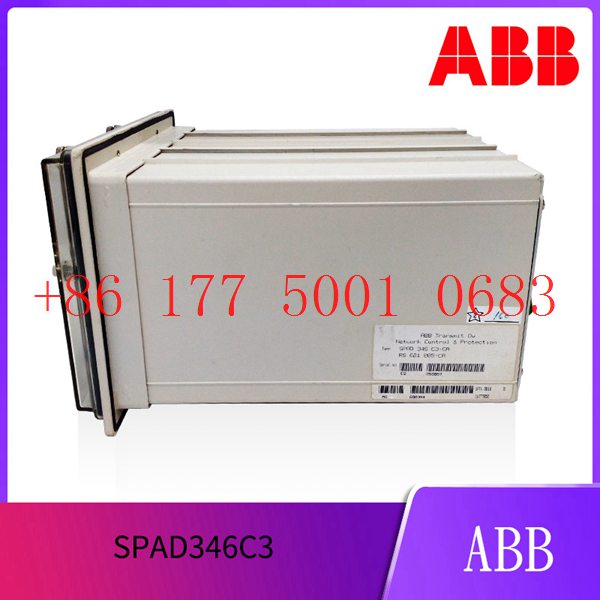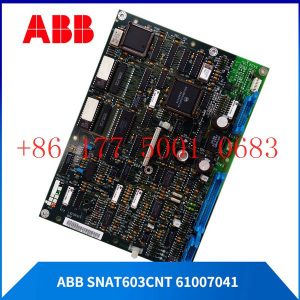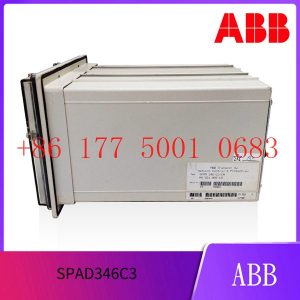Description
hardware flow control. It is an ideal choice in the field of industrial automation.
Nine Questions and Answers on Common Faults in ABB Industrial Robot Applications
Question 1: Under what circumstances do I need to back up my robot?
Answer: 1. After the new machine is powered on for the first time.
2. Before making any modifications.
3. After completing the modification.
4. If the robot is important, conduct it regularly once a week.
5. It is best to make a backup on a USB flash drive.
6. Delete old backups regularly to free up hard drive space.
Second question: What does the alarm message 10106 maintenance time reminder mean when the robot appears?
Answer: This is the intelligent periodic maintenance reminder of ABB robots.
Question 3: What should I do if the robot enters a system failure state when it is powered on?
Answer: 1. Restart the robot.
2. If it doesn”t work, check whether there is a more detailed alarm prompt on the teaching pendant and handle it.
3. Restart.
4. If it still cannot be lifted, try B startup.
5. If it still doesn’t work, try P startup.
6. If it still doesn’t work, try I startup (this will return the robot to factory settings, be careful).
Question 4: Can robot backup be shared by multiple robots?
Answer: No, for example, the backup of robot A can only be used for robot A, not robots B or C, because this will cause system failure.
Five questions: What files can be shared in the robot backup?
Answer: If the two robots are of the same model and configuration. You can share RAPID programs and EIO files, but they must be verified before they can be used normally.
Question 6: What is the mechanical origin of the robot? Where is the mechanical origin?
Answer: The six servo motors of the robot have a unique fixed mechanical origin. Incorrectly setting the mechanical origin of the robot will cause problems such
as limited movement or malfunction of the robot, the inability to walk in a straight line, etc., and serious damage to the robot.
Question 7: How to cancel the robot 50204 motion monitoring alarm?
Answer: 1. Modify the robot action monitoring parameters (control panel – action monitoring menu) to match the actual situation.
2. Use the AccSet command to reduce the robot”s acceleration.
3. Reduce the v_rot option in the speed data.
Eight questions: What should I do if the robot alarms “50296, SMB memory data difference” when it is powered on for the first time?
Answer: 1. Select calibration in the ABB main menu.
2. Click ROB_1 to enter the calibration screen and select SMB memory.
3. Select “Advanced” and click “Clear Control Cabinet Memory” after entering.
4. Click “Close” when finished, then click “Update”.
5. Select “The control cabinet or robot has been exchanged, and the control cabinet is updated using SMB memory data.”
Question 9: How to customize the speed of robot trajectory in the RAPID program?
Answer: 1. Select program data in the main menu of the teaching pendant.
2. After finding the data type Speeddata, click New.
3. Click on the initial value. The meanings of the four variables of Speeddata are: v_tcp represents the linear operating speed of the robot, v_rot
represents the rotational operating speed of the robot, v_leax represents the linear operating speed of the additional axis, v_reax represents the rotational
operating speed of the additional axis, if there is no additional axis, then No need to modify the two.
4. The customized data can be called in the RAPID program.
Display operation panel INPCI01
Display operation panel INPBS01
Display operation panel INNTP01
Display operation panel INNPM22
Display operation panel INNPM22
Display operation panel INNPM22
Display operation panel INNPM22
Display operation panel INNPM12
Display operation panel INNPM12
Display operation panel INNPM12
Display operation panel INNPM11
Display operation panel INNPM01
Display operation panel INNIS21
Display operation panel INNIS21
Display operation panel INNIS21
Display operation panel INNIS11
Display operation panel INNIS11
Display operation panel INNIS11
Display operation panel INNIS01
Display operation panel INNIS01
Display operation panel INNIS01
Display operation panel INLIM03
Display operation panel INLIM02
Display operation panel INIT03
Display operation panel INIT03
Display operation panel INIPT02
Display operation panel INIPT01
Display operation panel INIIT14
Display operation panel INIIT13
Display operation panel INIIT13
Display operation panel INIIT12
Display operation panel INIIT03
Display operation panel INIIT03
Display operation panel INIIT02
Display operation panel INIIT01
Display operation panel INIET800
Display operation panel INICT13A
Display operation panel INICT13A
Display operation panel INICT13
Display operation panel INICT12
Display operation panel INICT03A
Display operation panel INICT03A
Display operation panel INICT03
Display operation panel INICT03
Display operation panel INICT01
Display operation panel INICT01
Display operation panel INICT01
Display operation panel INICT01
Display operation panel INFBA01
Display operation panel INFBA01
Display operation panel INDDM01
Display operation panel INDDM01
Display operation panel INBTM01
Display operation panel INBTM01
Display operation panel INBIM02
Display operation panel INBIM02
Display operation panel IMUSM01
Display operation panel IMUSM01
Display operation panel IMTSA01
Display operation panel IMTSA01
Display operation panel IMSPM01
Display operation panel IMSPM01
Display operation panel IMSET01
Display operation panel IMSET01
Display operation panel IMSET01
Display operation panel IMSET01
Display operation panel IMSER02
Display operation panel IMSER02
Display operation panel IMSED01
Display operation panel IMSED01
Display operation panel IMSED01
Display operation panel IMSED01
Display operation panel IMRIO02
Display operation panel IMRIO02
Display operation panel IMRIO02
Display operation panel IMRI002
Display operation panel IMRDO01
Display operation panel IMRDO01
Display operation panel IMRDI13
Display operation panel IMRDI13
Display operation panel IMRDI01
Display operation panel IMRDI01
Display operation panel IMRCC02
Display operation panel IMRCC02









Reviews
There are no reviews yet.